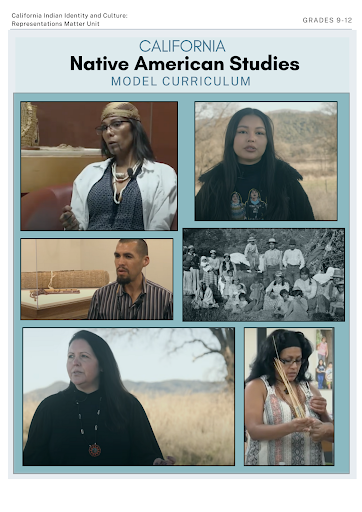Overview
Free Resources!
California Indian Identity and Culture: Representations Matters Unit

Author(s) : This unit was researched, authored, and edited by the California Indian Museum and Cultural Center, California Indian Education for All, and the San Diego County Office of Education. Key writers and researchers of this unit are Nicole Lim, Jayden Lim, Ramiro Medina, and Dr. Staci Block. The unit resources were designed and created from funding through the California Department of Education’s Native American Studies Model Curriculum grant and contract.
Grade(s) : 9-12th Grades
Suggested Amount of Time : There are 13 instructional lessons in the unit. Each lesson will take approximately 90 minutes to complete. Please note that each lesson will include a reflective talking circle to allow students to process and reflect on the Essential Understandings of California Indian History and Culture and 6Ps Indigenous Critical Orientations. This unit will take approximately 3 weeks to complete in a 90 minute class period or approximately 4 weeks to complete in a 60 minute class period.
Curriculum Themes:
- History
- Cultural Strengths
- Law/Government
- Relationship to Place
- Cross Curricular Integration
Learning Goals
Students will demonstrate an understanding of cultural awareness, including historical and modern contexts that shape/influence California Native American Tribes.
Students will recognize how history and culture may impact tribal cultures and how non-tribal agencies can work in coordination with tribal communities.
Students will highlight the role of tribal culture, perspectives, and resilience in tribal education.
Students will plan and design activities that address the issue emphasizing tribal cultural values, leadership principles, and civic responsibilities.
Students will have opportunities to learn from and engage with tribes, tribal communities, and tribal organizations.
Students will increase civic education learning skills of Native and non-Native youth so that they may become more active problem solvers within their own communities and the wider community.
Students will have an opportunity to participate in collaborative learning to partner tribes and organizations to conduct effective service learning.
Students will learn the foundational understanding of tribal, state, and federal governments, with a particular focus on Native Americans' roles as citizens within these three communities.
Students will explore the unique position that Native Americans hold in the United States, as they potentially belong to tribal, state, and national communities, whereas most U.S. citizens are only part of state and national communities.
Students will develop skills to analyze primary documents, photographs, and digital media.
Lesson Overview
This unit invites students to critically examine the problematic representations and stereotypes of Native Americans in both historical and contemporary visual culture. Through the exploration of images used to market products at the turn of the twentieth century from the California State Archives’ Trademarks and Service Marks collection, students will gain insight into how these stereotypes were commercialized. They will also engage with current Native perspectives on misrepresentation by watching videos from the California Indian Museum and Cultural Center. Additionally, students will participate in activities that analyze the portrayal of Native Americans in mass media today. This resource encourages students to think deeply about the ongoing issues of Native American stereotypes, representation, and identity in both the past and present.
Ultimately, the unit will support California youth to engage in civics education, design thinking, and service learning projects that explore issues that face them and their communities directly. The youth will plan and design activities that address the issue emphasizing tribal cultural values, leadership principles, and civic responsibilities. There will be opportunities for projects to engage with tribes, tribal communities, and tribal organizations. Our major goals are to increase civic skills of Native and non-Native youth so that they may become more active problem solvers within their own communities and the wider community. Additionally, students will have opportunities to participate in collaborative learning to partner tribes and organizations to conduct effective service learning.
Teacher Background
This unit will help students explore the problematic representations and stereotypes of Native Americans in past and present visual culture. Students will analyze images of Native Americans that were used to sell products at the turn of the twentieth century from the California State Archives’ Trademarks and Service Marks collection, listen to current Native perspectives on the misrepresentations that they still encounter today in videos from the California Indian Museum and Cultural Center, and complete a series of related activities focused on Native American stereotypes in mass media in the U.S. This resource invites students to think critically about historical and contemporary issues concerning Native American stereotypes, representation, and identity.
Educators Guide and Videos to the Essential Understandings of California Indian History and Culture
Please take time to read through this document and watch these videos to learn from California Indian cultural bearers as they teach the Essential Understandings of California Indian History and Culture. (https://bit.ly/NASMC_EU)
Essential Understanding 1: Great Diversity Among Tribes (EU1 Video) https://bit.ly/NASMC_EU1
Essential Understanding 2: Diversity Among Identity (EU2 Video) https://bit.ly/NASMC_EU2
Essential Understanding 3: Native Traditional Beliefs (EU3 Video) https://bit.ly/NASMC_EU3
Essential Understanding 4: Policies that Affected Tribes (EU4 Video) https://bit.ly/NASMC_EU4
Essential Understanding 5: Reservations (EU5 Video) https://bit.ly/NASMC_EU5
Essential Understanding 6: History from a California Indian Perspective (EU6 Video) https://bit.ly/NASMC_EU6
- Essential Understanding 7: Tribes Have Sovereign Powers (EU7 Video) https://bit.ly/NASMC_EU7